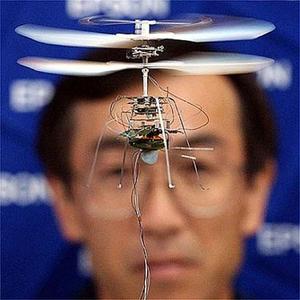Shape of things to comeRobot assembles itself, then flies
Soldiers and first responders often find themselves in situations of surveillance or search and rescue, in which they may have to figure out on the fly what size and shape surveillance or search-and-rescue robot they need; Swiss researchers develop a flying platform made up of autonomous wheeled vehicle that lock together to share the task of controlled and autonomous flight; this self-sufficient wheeled DFA has another advantage: if one of the parts of which it consists breaks, the robot can reconfigure itself or substitute in a different part

One of ETH Zurich's designs // Source: youngester.com
A flying platform from ETH Zurich is made up of autonomous wheeled vehicle that lock together to share the task of controlled and autonomous flight. The robot, dubbed the Distributed Flight Array (DFA), was presented by Raymond Oung, Raffaello D’Andrea, and others at this year’s IEEE International Conference on Robotics and Automation (ICRA) which was held in Anchorage, Alaska, from 3 to 8 May. The paper was a finalist for best conference paper.
Each wheeled vehicle has its own power, motor, propeller, flight control system, sensors, and wireless communication. The researchers write on their Web site that “joined together, however, these relatively simple modules evolve into a sophisticated multi-propeller system capable of coordinated flight.”
The individual robots dock together at random, bound by magnets — but the robots does not simply fly in a locked positions with the others. They form a network, exchanging sensor information so that each robot can figure out how much thrust is needed (based on its place in the system) for the whole array to take off.
Once the system is hovering, the robotic modules can correct for disturbances, based on their place in the configuration and the system’s overall motion. When the robot is done flying, it breaks apart and each robot falls harmless to the ground (see the DFA in action in this 2009 video).
Kristina Grifantini writes that the DFA could be useful for situation of surveillance or search and rescue, in which one may have to figure out on the fly what size and shape robot one needs. Also, a robot made of many identical modules like this is likely to be more robust — if one part breaks, it can reconfigure or substitute in a different one.
-Read more in Raymond Oung et al., “The Distributed Flight Array” (paper presented at the 2010 IEEE International Conference on Robotics and Automation, Anchorage Convention District, Anchorage, Alaska, 3-8 May 2010)
